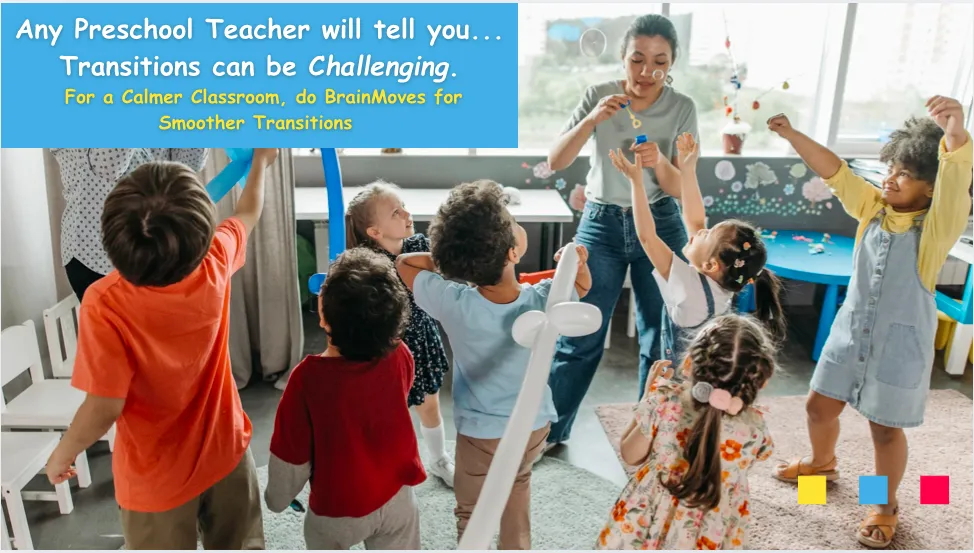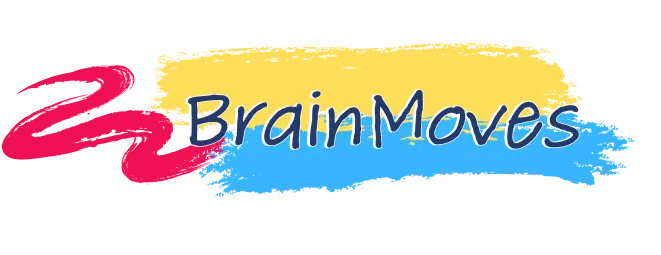
Any Preschool Teacher will tell you... Transitions can be Challenging.
Any teacher can will tell you classroom transitions can be hard. Today we are going to match some specific BrainMoves movements to some specific classroom transitions to make class rooms more peaceful and productive.
Every child can be challenged by the exciting nature of the preschool classroom. Preschool classrooms are designed to engage young minds while also preparing them for times when they have to sit, concentrate, and pay attention. This helps develop the habits that will serve them throughout their time in school and later in the workplace. Being able to sit, listen, and transition between tasks and conversations will also help them in social settings. However, many children have difficulty transitioning between tasks, and their naturally black-and-white thinking can lead to frustration. This may cause some children to feel anxious, while others may become oppositional.
Why are transitions so challenging? Let’s look at five transitions that can pose challenges in the classroom and list the reasons why.
1. Transitioning from being dropped off by parents to walking into the classroom and taking their seat alone.
Why is this hard?
This is complicated because they’re moving from the protection of their parents to needing to be aware of their surroundings. Especially if they’re uncertain of the rules or what is required of them first thing in the morning, they may be inclined to cling to their parent, act out, or become emotional. Ask them to do the Skunk which helps regulate the nervous system through calm breathing, calm anxiety, improve concentration and balance.
2. Putting down creative toys, crayons, markers, and paint, and moving to cleaning up before a quiet activity.
Why is this transition tough?
Children are task-focused when working on a project where there are few rules; they are free to either be loud or quiet and neat or messy. They have to stop regardless of whether or not they think they’re actually finished and then move to wrapping up their project and sitting quietly while paying attention to someone else. The Parrot BrainMove is great here because it helps a child with organization, encourages the child to see the things they need to finish up, observe how to put things away, and then watch the teacher for instructions on how and where to sit quietly.
3. Transitioning from sitting or working quietly to standing in line for lunch or a snack.
Why is this challenging?
Little brains that are thinking a lot get hungry and need those calories to think well, so snacks and lunch make children very excited. They may have difficulty waiting in line and being patient, even if they were previously sitting quietly. This can make deciding who is standing and waiting tricky for them to follow and the change in sound between a quiet room and a busy room full of moving people and pushing chairs can make the room louder too. Do the Kangaroo to help get more oxygen into their brains and calm their nervous systems.
4. Settling for quiet time after lunch or recess.
Why is this transition tough?
Bodies in motion may wish to remain in motion, and children who are enjoying being active may not feel ready to stop. Especially if the quiet time involves a nap or some sort of silent activity, it would be useful to do some BrainMoves movements to help them settle.
The Bear Cub can help children calm down and it is done on the floor making it perfect for nap or storytime.
5. On the playground, when a child needs to give up their seat on a swing or in the classroom when it’s someone else’s turn to use a particular toy or tool.
Why is this challenging?
When two children want to use the same toy or piece of playground equipment at the same time, and if they are a bit tired or overstimulated, sharing can become a challenge. This can make some children possessive and hold on while others might try to snatch the item. If there’s going to be an activity that requires a lot of sharing back-and-forth, do the Startup Six to help the children’s brains and bodies ready for observing, participating and staying calm. This will help them pay attention to each other.
6. When a loud sound like a bell or an alarm goes off.
Why is this transition tough?
The suddenness of this can bother even the calmest child and can be hard for preschoolers in “ big school” environments or older students alike. The loud sound can trigger the startle reflex in some people and can make a brain temporarily go blank. This is challenging because the child needs to DO something immediately on hearing the sound. If time permits, do the Koala Cub to help them continue to be willing to listen and refocus their attention on important follow up sounds like instructions for a fire drill, or instructions to pick up all their things in preparation for going home.
Transitions in a preschool classroom can be tricky for many children. As they move from one activity to another, they face challenges that can make them feel anxious or frustrated. Understanding these struggles and using BrainMoves to smooth transitions helps teachers and parents support preschoolers as they learn to navigate changes each day. By using movements like BrainMoves and encouraging patience, we can help make these transitions smoother for everyone. With practice, children can develop the skills they need to handle changes with confidence, making their time in school more enjoyable and less stressful.
You can learn BrainMoves this summer in as little as five minutes a day with the Self Paced , Online Brainmoves Course.
Buy today and enjoy access to the course for a lifetime!



